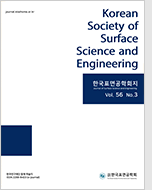
- Past Issues
- e-Submission
-

2021 Impact Factor 1.766
5-Year Impact Factor 1.674
Editorial Office
- +82-2-563-0935
- +82-2-558-2230
- submission@kssse.or.kr
- https://www.kssse.or.kr/

2021 Impact Factor 1.766
5-Year Impact Factor 1.674
The Korean Society of Surface Science and Engineering 2023;56(6):427-436. Published online: Dec, 28, 2023
DOI : 10.5695/JSSE.2023.56.6.427
In the industry, it is recognized that human activities significantly lead to a large amount of wastewater, mainly due to the increased use of water and energy. As a result, the growing field of wastewater resource technology is getting more attention. The common technology for hydrogen production, water electrolysis, requires purified water, leading to the need for desalination and reprocessing. However, producing hydrogen directly from wastewater could be a more cost-effective option compared to traditional methods. To achieve this, a series of first-principle computational simulations were conducted to assess how waste nutrient ions affect standard electrolysis catalysts. This study focused on understanding the adsorption mechanisms of byproducts related to the oxygen evolution reaction (OER) in anion exchange membrane (AEM) electrolysis, using Co3O4 as a typical non-precious metal catalyst. At the same time, efforts were made to develop a comprehensive free energy prediction model for more accurate predictions of OER results.
Keywords : Electrolysis, Electrocatalyst, Oxygen evolution reaction, Density Functional Theory, Waste nutrient solutions